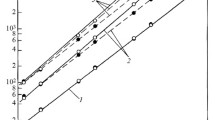Abstract
The problem of heat transfer in the wall region of a turbulent boundary layer has been investigated. The resonant triad in the theory of hydrodynamic stability was used to obtain the velocity field induced by the coherent structures in the wall region of the turbulent boundary layer, while the small scale turbulence was represented by a simple model. By such a new approach of modeling, the 3-D temperature field is calculated, the mean temperature profile in the wall region and the Nusselt number characterizing the heat flux, which was found to be in good agreement with the experimental observations are obtained. The instantaneous temperature field had streaky structures, thus offering a mechanism for their generation found in numerical simulations.
Similar content being viewed by others
References
Zhou, H., Xiong, Z. M., On the mechanism for the generation of the coherent structures in the wall region of a turbulent boundary layer,Science in China, Ser. A, 1994, 38(2): 188.
Luo J. S., Zhou H., A theoretical model for the large scale coherent structures in the outer region of a turbulent boundary layer and its comparison with the experimental observations,Science in China, Ser. A, 1993, 36(7): 825.
Zhou, H., Lu, L. P., Effect of pressure gradient on coherent structures in a turbulent boundary layer,Science in China, Ser. A, 1997, 40(4): 441.
Lu, L. P., Luo, J. S., Xiong, Z. M., The improvement of the modeling of the large scale coherent structures in the outer region of a turbulent boundary layer,Progress in Natural Science Communication of National Key Laboratories (in Chinese), 1996, 6(6): 741.
Nagano, N., Tagawa, M., Coherent motions and their role in transport processes in a wall turbulent shear flow,Flow Modeling and Turbulence Measurement (eds. Chen, C. J.), Rotterdam/Brookfield: A. A. Balkama, 1996, 17.
Blackwelder, R. F., Analogies between transitional and turbulent boundary layers,Physics of Fluids, 1983, 26: 2807.
Kachanov, Yu. S., On the resonant nature of the breakdown of a laminar boundary layer,J. F. M., 1987, 184; 43.
Hinze, J. O.Turbulence, New York: McGraw-Hill, 1975.
Ying, L. A., Zhang, P. W.,Method of Vorticity (in Chinese), Beijing. Science Press, 1993.
Bell, D. M., Ferziger, J. H., Turbulent boundary layer DNS with passive scalars,Near Wall Turbulent Flow (eds. So, R. M., Spezial, C. G., Launder, B. E.), Elsevier: Science Publisher, B. V., 1993, 327.
Author information
Authors and Affiliations
Additional information
Project supported by the National Natural Science Foundation of China (Grant No. 19132011).
Rights and permissions
About this article
Cite this article
Zhou, H., Ma, Z. & Zhang, Z. The heat transfer problem in the wall region of a turbulent boundary layer. Sci. China Ser. A-Math. 41, 1216–1222 (1998). https://doi.org/10.1007/BF02871984
Received:
Issue Date:
DOI: https://doi.org/10.1007/BF02871984



